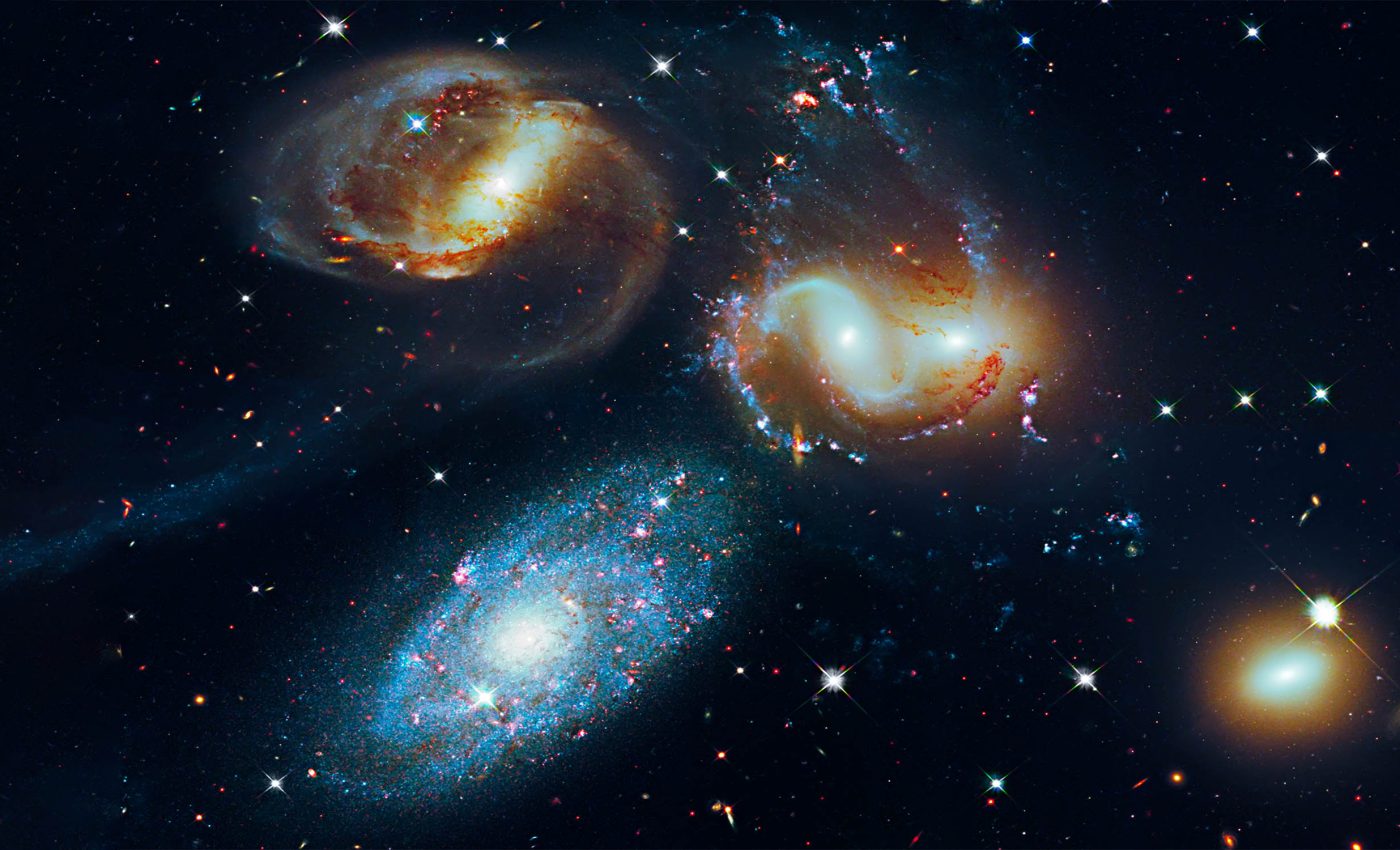
Galaxies colliding at 2 million miles per hour observed in unprecedented detail
A galaxy racing through space at an astonishing speed of two million mph (3.2 million km/h) has created a dramatic collision, observed in unprecedented detail by one of Earth’s most advanced telescopes.
The event occurred in Stephan’s Quintet, a well-known group of five interacting galaxies first discovered nearly 150 years ago.
The collision unleashed a powerful shockwave described as being akin to a “sonic boom from a jet fighter,” showcasing one of the Universe’s most striking phenomena.
The galaxy responsible, NGC 7318b, passed through Stephan’s Quintet, triggering the reactivation of a chaotic field of debris left behind by previous galactic collisions.
This rare event was captured by the William Herschel Telescope Enhanced Area Velocity Explorer (WEAVE), a state-of-the-art spectrograph located in La Palma, Spain.
Stephan’s Quintet: A galactic crossroad
“Since its discovery in 1877, Stephan’s Quintet has captivated astronomers because it represents a galactic crossroad where past collisions between galaxies have left behind a complex field of debris,” explained lead author Marina Arnaudova, an astronomer at the University of Hertfordshire.
“Dynamical activity in this galaxy group has now been reawakened by a galaxy smashing through it at an incredible speed of over two million mph, leading to an immensely powerful shock, much like a sonic boom from a jet fighter.”
This new insight into Stephan’s Quintet was achieved using WEAVE’s Large Integral Field Unit (LIFU), part of a €20-million (£16.7-million) next-generation science facility.
WEAVE’s capabilities allow astronomers to explore the composition and behavior of stars and gasses within galaxies, offering unprecedented detail about the dynamics of galactic interactions.
The dual nature of the shockwave
One of the study’s most significant findings was the dual nature of the shockwave produced by the collision.
“As the shock moves through pockets of cold gas, it travels at hypersonic speeds – several times the speed of sound in the intergalactic medium of Stephan’s Quintet – powerful enough to rip apart electrons from atoms, leaving behind a glowing trail of charged gas, as seen with WEAVE,” Arnaudova said.
However, the shock behaves differently when it interacts with surrounding hot gas.
“Instead of causing significant disruption, the weak shock compresses the hot gas, resulting in radio waves that are picked up by radio telescopes like the Low Frequency Array (LOFAR),” explained Soumyadeep Das, a PhD student at the University of Hertfordshire.
Advanced instruments unlock new insights
The detailed observations combined data from WEAVE with those from other cutting-edge instruments, including LOFAR, the Very Large Array (VLA), and the James Webb Space Telescope (JWST).
WEAVE, which is attached to the William Herschel Telescope, analyzes light from stars and gas through spectroscopy.

This process reveals a “bar code” of colors that uncovers the elements present in stars, providing crucial information about galactic composition and behavior.
This advanced spectrograph was developed through an international partnership involving France, Italy, Spain, the Netherlands, and the UK.
Its primary mission is to provide groundbreaking insights into the formation of the Milky Way and other galaxies, as well as the evolution of the Universe.
A glimpse into galactic evolution
Stephan’s Quintet offers a unique laboratory for understanding the violent interactions between galaxies.
Professor Gavin Dalton is the WEAVE principal investigator at RAL Space and the University of Oxford.
“The shock and the unfolding collision that we see in Stephan’s Quintet provide a remarkable perspective on what may be happening in the formation and evolution of the barely resolved faint galaxies that we see at the limits of our current capabilities,” said Dalton.
“It’s really neat work that Marina has put together with this large team, but this first WEAVE science paper also represents just a taste of what is to come over the next five years now that WEAVE is becoming fully operational,” added Daniel Smith of the University of Hertfordshire.
A promising future for galactic research
The findings mark an exciting beginning for WEAVE’s role in astronomy.
“I’m excited to see that the data gathered at the WEAVE first light already provide a high-impact result, and I’m sure this is just an early example of the types of discoveries that will be made possible with WEAVE on the William Herschel Telescope in the coming years,” said Marc Balcells, director of the Isaac Newton Group of Telescopes.
By capturing the details of this dramatic galactic collision, WEAVE has demonstrated its potential to revolutionize our understanding of the cosmos.
With its ability to analyze light from stars and gasses with unprecedented speed and accuracy, the spectrograph is set to uncover more insights into galaxy formation, evolution, and the chaotic interactions shaping the Universe.
Image Credit: University of Hertfordshire
—–
Like what you read? Subscribe to our newsletter for engaging articles, exclusive content, and the latest updates.
Check us out on EarthSnap, a free app brought to you by Eric Ralls and Earth.com.
—–













